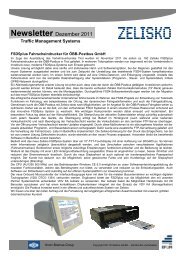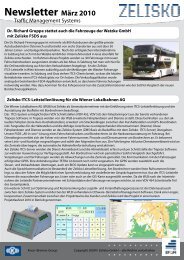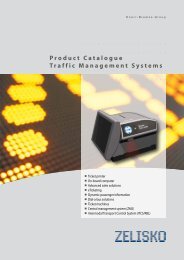Annual Report 2012 - Knorr-Bremse AG.
Annual Report 2012 - Knorr-Bremse AG.
Annual Report 2012 - Knorr-Bremse AG.
You also want an ePaper? Increase the reach of your titles
YUMPU automatically turns print PDFs into web optimized ePapers that Google loves.
60 <strong>Report</strong> ProduCts // Rail vehicle systems<br />
Rail Vehicle Systems<br />
Thanks to the new<br />
“whisper brake pad”,<br />
the “Italo” Italian<br />
high-speed train<br />
operates extremely<br />
silently.<br />
<strong>Knorr</strong>-<strong>Bremse</strong> develops innovative “whisper brake pad”<br />
The noise of train brakes can cause considerable annoyance to residents in the vicinity of railway lines,<br />
but now <strong>Knorr</strong>-<strong>Bremse</strong> has developed a new high-performance brake pad that virtually eradicates<br />
brake squeal and makes rail transportation more environmentally friendly – the high-tech Flexpad<br />
Silent.<br />
Brake squeal is caused mainly by a stick-slip effect that occurs at slow speeds as a result of the low<br />
clamping force of the brake pads and low rotational speed of the brake disc. The brake pad repeatedly<br />
adheres briefly to the disc, causing vibrations that trigger the unpleasant noise.<br />
<strong>Knorr</strong>-<strong>Bremse</strong> tackled this problem on two fronts. To prevent the pads sticking to the disc, a compound<br />
material was used that combines a high-friction sintered surface with a lubricated core. And a<br />
mechanical sound damper was also developed with sound insulation between the pad and the<br />
backing plate to absorb any vibration.<br />
Having gained official approval, the “whisper brake pad” is now ready for use – and that includes the<br />
high-speed sector. Since April of this year the Flexpad Silent has been in operation on Italy’s “Italo”<br />
high-speed train – the “Ferrari on Rails” – on the line between Milan and Naples.<br />
<strong>Knorr</strong>-<strong>Bremse</strong> launches highly complex brake control module<br />
Brake control modules are essential to any braking system. Installed in the engine room of the locomotive,<br />
they not only contain the control unit for the locomotive’s pneumatic brakes but also regulate the<br />
brakes for the entire train via the main brake pipe. The equipment trestle integrates electrical and<br />
electronic components, pneumatic control and air reservoirs and the brake equipment panel. During<br />
the year in question, <strong>Knorr</strong>-<strong>Bremse</strong> developed a highly sophisticated brake control module of this kind<br />
designed to operate at temperatures down to minus 50 degrees Celsius.<br />
The module forms part of a braking system, the first examples of which were delivered to vehicle manufacturer<br />
Alstom during <strong>2012</strong> for installation in 25 double freight locomotives ordered by rail operator<br />
Kazakhstan Temir Zholy for use in Kazakhstan. Amongst other things the braking system includes the<br />
specially designed KAB60 control valve and the BP Compact electronic HL control system modified to<br />
meet the operating regulations of the GOST market.<br />
In the run-up to its successful low-temperature testing of the braking system, <strong>Knorr</strong>-<strong>Bremse</strong> had invested<br />
heavily in acquiring the necessary development expertise to manufacture GOST-standard<br />
products for the Russian and CIS markets. <strong>Knorr</strong>-<strong>Bremse</strong> now also operates the only accredited testing<br />
center outside Russia that is permitted to carry out certification of GOST components.<br />
The order from Kazakhstan is doubly important for <strong>Knorr</strong>-<strong>Bremse</strong>. Firstly the customer has already taken<br />
out an option on 175 more double locomotives; and secondly, delivery of complete locomotive<br />
braking systems to Kazakhstan has enabled <strong>Knorr</strong>-<strong>Bremse</strong> to demonstrate its GOST competence –<br />
which should stand the company in good stead when tendering for future projects in other CIS states.<br />
Brake control system includes condition monitoring of bogie components<br />
In the past, the main purpose of the brake control system was to operate the brakes and monitor their<br />
functioning, as well as calculating vehicle speed and diagnosing wheelset rotation. Now, by doubling<br />
up sensors and making intelligent use of existing interfaces, <strong>Knorr</strong>-<strong>Bremse</strong> has been able to extend its



![1 Newsletter 2013 Version 0 92 [Kompatibilitätsmodus] - Zelisko](https://img.yumpu.com/50939577/1/184x260/1-newsletter-2013-version-0-92-kompatibilitaatsmodus-zelisko.jpg?quality=85)




![Backofficelösung ZMS [PDF, 740 kB] - Zelisko](https://img.yumpu.com/33964695/1/184x260/backofficelaasung-zms-pdf-740-kb-zelisko.jpg?quality=85)

![Geschäftsbericht 2012 [PDF, 13 MB] - Zelisko](https://img.yumpu.com/31517535/1/184x260/geschaaftsbericht-2012-pdf-13-mb-zelisko.jpg?quality=85)


![Produktkatalog Gesamtlösungen [PDF, 4 MB] - Zelisko](https://img.yumpu.com/22973479/1/182x260/produktkatalog-gesamtlaasungen-pdf-4-mb-zelisko.jpg?quality=85)
![ITCS Datenblatt [PDF, 804 kB] - Zelisko](https://img.yumpu.com/22855155/1/184x260/itcs-datenblatt-pdf-804-kb-zelisko.jpg?quality=85)
![Fahrscheindrucker FSD5plus [PDF, 934 kB] - Zelisko](https://img.yumpu.com/22822643/1/184x260/fahrscheindrucker-fsd5plus-pdf-934-kb-zelisko.jpg?quality=85)
